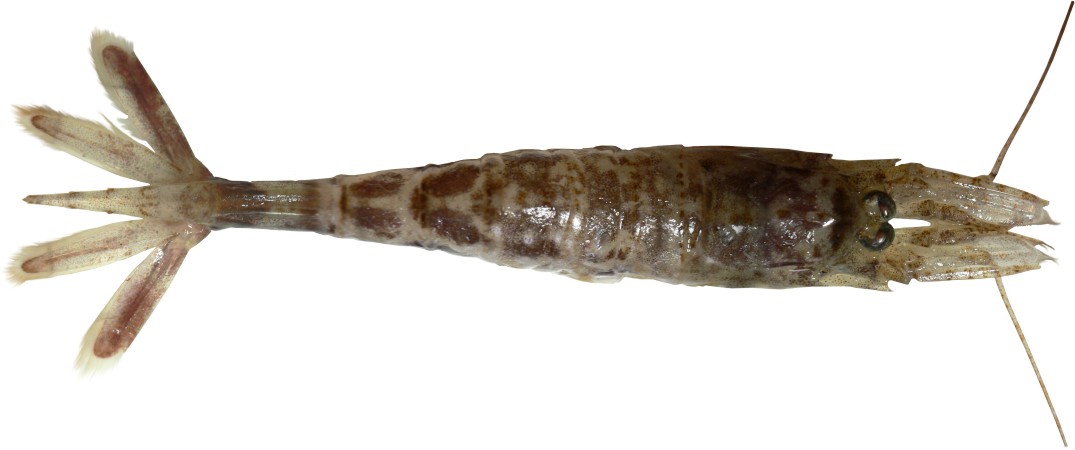Neocrangon
communis (Rathbun,
1899)
Common name(s): Gray shrimp, twospine crangon, common two-spined crangon
|
| Synonyms:
Crangon communis, Sclerocrangon communis |
 |
|
Phylum Arthropoda
Subphylum Crustacea
Class Malacostraca
Subclass Eumalacostraca
Superorder Eucarida
Order Decapoda
|
| Adult female Neocrangon communis
from 308 m depth near the southwest coast of Kamchatka |
| (Photo by: Andrey Gontchar
) |
Description:
As with other members
of Family Crangonidae, this species has a subchelate
pereopod
1 and the carpus
of pereopod
2 is not subdivided into several units. Neocrangon
communis
has a rostrum
less than half as long as the carapace
(as is true for most local Crangonids) and has 5 pairs of thoracic
legs.
The dactyl of leg 5 is not broad and flattened. The eyestalks
are
not parallel and shielded by a spiny hood. The rostrum has a
rounded
tip. It does not extend beyond the eyes and does not have a
ventral
expansion. They eyes are not contiguous. The
carapace has two
median dorsal spines, which are in the anterior half. The
anterior
median dorsal spine does not extend beyond the bases of the orbits of
the
eyes and isslightly smaller than the posterior one.
The median
dorsal carina extends back to the posterior half of the
carapace.
A large branchiostegal spine is present. The general surface
of the
carapace is smooth, not sculptured. There is no submedian spine on the
carapace. Color is gray over much of the body, with brown over the gill
area. Has pale yellow spots and fine brown to charcoal
spots.
Brown spots and blotches on the abdomen, with light yellow spots along
the side (except on the 5th abdominal segment). Telson and
uropods
have brown spots. The outer margin if the outer uropod is
magenta.
Light pubescence on the anterior part of the carapace and in some of
the
grooves of the abdomen, easily rubbed off. Male length up to
6.1
cm, females to 8 cm.
How to Distinguish from
Similar Species:
Geographical Range:
Japan,
Chukchi Sea, Russia, Alaska, British Columbia down to central
California
Depth Range:
16 m down to at least
1537 m.
Habitat:
Mud or mud and sand bottoms
Biology/Natural History:
This is one of the most common subtidal shrimp in this area.
It sometimes
swims up into the water column, to at least 100 m off the
bottom.
Ovigerous females can be found in January-February and
May-September.
They bear about 2200 eggs.
Parasites include the branchial parasitic isopod Argeia
pugettensis (especially in Puget Sound) and the
rhizocephalan barnacle Mycetomorpha
vancouverensis.
The genus Neocrangon is separated from Crangon
by the
fact that Crangon has an arthrobranch gill on the
third maxilliped
and one median spine, while Neocrangon does not
have the arthrobranch
gill on the third maxilliped but does have the single median
spine.
Butler (1980) notes that along our coast this species does not have the
arthrobranch gill but it has two median dorsal
spines instead of
one. On this basis, Butler (1980) decided the separation of
the two
genera is invalid and called this species C. communis.
Lamb
and Hanby (2005) also follow this nomenclature.
References:
Dichotomous Keys:
Kozloff, 1987, 1996
General References:
Butler,
1980 (as Crangon communis)
Lamb
and Hanby, 2005 (as Crangon communis)
Ricketts
et al., 1981
Scientific Articles:
Web sites:
General Notes and
Observations: Locations,
abundances, unusual behaviors:
Authors and Editors of Page:
Dave Cowles (2009): Created original page
CSS coding for page developed by Jonathan Cowles (2007)
Rosario Invertebrates web site provided courtesy of Walla
Walla University
|
